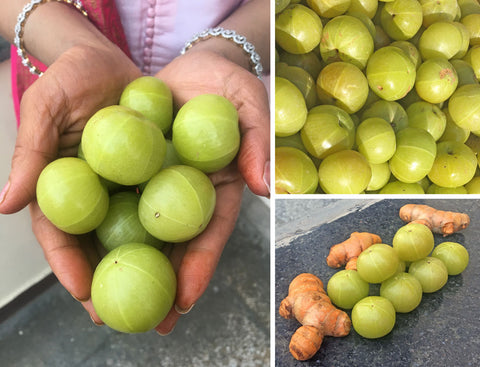
Amla Powder Fine Ground, Certified Organic - 8 oz
Our organic amla powder is made from the fruit of the Indian Gooseberry (ie Amalaki or Amla) tree. Amla is an astringent-tasting native Indian fruit traditionally used in Ayurveda. While it is often taken internally, external use of amla powder for hair is common as well.
Our amla powder is dried using a dehydrator. It is not sun-dried, which would make it very dark in color. Extremely low heat is used during the entire process of converting fresh de-seeded amla fruits to powder. The temperature is kept below 104°F at all times. This ensures that delicate nutrients are preserved during the entire process.
This product has been lab tested for heavy metals, and it complies with U.S. federal and state laws. Color may vary.
Fine Ground. Dissolves completely in water.
We do not use any anti-clumping agents. Our product is 100% Pure Amla Powder with nothing else added. Any clumps are natural and normal and can be broken up by crushing with the back of a spoon.
What is Amla (i.e. Amalaki, or Indian Gooseberry)?

Species: Emblica officinalis; syn. Phyllanthus emblica
Other names: Indian gooseberry, emblic myrobalan, amalaki
Appearance: The berries are greenish yellow with a fibrous inner texture. The powder is a rich brown color.
Typically used: Powdered
Origin: The amla tree holds a high significance in Hinduism and is considered to be sacred to the goddess Lakshimi, so many use organic amla powder spice for cooking, as well as in traditional Ayurdevic medicine in order to balance Pitta. The berries ripen on this small to medium deciduous tree in autumn and must be harvested by hand from the top branches.
Flavor: Sour, bitter, astringent, fibrous
Aroma: Like raisins or tea
Culinary uses: The fibrous fruit can be eaten raw, but is more commonly pickled or softened with oil, salt, and spices. They can also be soaked in sugar syrup until they become candied.
Other uses: This organic amalaki fruit powder is packed with vitamin C and has been used in Ayurvedic practices. Its high tannin content also makes it suitable for inks, dyes, shampoos, and hair oils.
Make Amla Powder Tea: Boil ½ tsp in 8 oz water for 10 minutes, steep it for about an hour, filter it and then drink it.
Make Amla Powder Lemonade: Add 1 TBSP amla powder to 2 quarts of fresh lemonade and whisk vigorously until fully dissolved.
Ways to Use Amla Powder
Because Amla has so many great benefits, you’ll want to use it regularly. Fresh Amalaki fruit is not readily available in many parts of the world. Fortunately, dried organic Amla Powder is an ideal way to use this amazing fruit.
Here are 25 recipes and ideas to get you started:
- Make Balsamic Vinaigrette: Blend 6 tablespoons extra virgin olive oil with 2 tablespoons balsamic vinegar, 1 teaspoon Dijon mustard, 1 teaspoon raw honey, ¼ teaspoon minced dried onions or onion powder and ¼ teaspoon Amla Powder. Delicious over leafy greens, bell peppers and cucumbers.
- Fortify Hummus: Mix 1/8 teaspoon Amla Powder into 1 cup of favorite hummus (homemade or store-bought). Drizzle with extra virgin olive oil and sprinkle with your choice of fresh herbs (chives, parsley, cilantro, mint, or basil).
- Make a Banana Smoothie: Puree 1 cup of coconut or other non-dairy nut milk with 1 banana, 1-2 dates, a tablespoon of almond, cashew or peanut butter, a dash of vanilla extract and 1/8-1/4 teaspoon Amla Powder.
- Cool yourself and your loved ones in the summertime heat with a Pineapple Coconut-Yogurt Amla Smoothie. Blend 1 cup unfiltered, organic apple juice, 1 cup pineapple juice, 1 10-ounce bag frozen fruit (berries, mango, peaches, etc.), 1 6-8 ounce carton of coconut milk yogurt, ¼ teaspoon Amla Powder, and a few mint sprigs.
- Nourish your digestive system: Simmer almond or coconut milk gently for 5-10 minutes. Cool slightly; add a pinch of each of the following: Amla Powder, ginger, cardamom, cinnamon, turmeric and black pepper. Add honey, coconut palm sugar, jaggery, or other natural sugar to taste.
- Make a green smoothie: Blend 1 cup unfiltered organic apple juice with 2 large scoops of non-dairy yogurt (try vanilla), 2 handfuls of organic baby spinach, 1 tablespoon chopped, peeled fresh ginger root, 2 organic seeded, cored and quartered green apples (Granny Smith), and ¼ teaspoon Amla Powder.
- Enjoy homemade apple cider: Simmer unfiltered organic apple juice with cinnamon, cloves, allspice and orange peel for 10 minutes. Strain; add Amla Powder to taste. Relax and enjoy!
- Mix fresh vegetable juice such as carrot, cucumber, spinach and tomato with a healthy pinch of Amla Powder.
- Mix fresh fruit juice such as orange, pineapple, grapefruit, apple, pear or grape juice with a healthy pinch of Amla Powder. For added benefit, add a pinch of ginger.
- Make a health drink every morning: Mix ½ teaspoon Amla powder with 1 teaspoon raw honey and a pinch of turmeric powder. Add hot (not boiling) water, stir and enjoy.
- Make a quart of Amla Lime Aid: Blend in a blender 4 cups of hot water with ½ cup lime juice, ½ cup organic raw sugar, 1 teaspoon of peeled and chopped fresh ginger root, and 1 teaspoon of Amla Powder. Chill and serve with lime, lemon or orange slices.
- Add a healthy pinch of Amla Powder to your favorite herbal tea such as Mandarin Orange, Rosehips, fruit teas, and ginger tea. Add honey and lemon if desired.
- Try a pinch of Amla powder in a cup of hot Chai Tea made with cinnamon, cardamom, turmeric, black pepper, raw sugar or Indian Jaggery and coconut milk. Use regular or decaf black or green tea.
- Make a cooling summertime beverage by blending seedless cucumbers, lime juice, mint leaves, yogurt and a pinch of Amla powder in a blender. Sweeten if desired with dates, organic raw sugar or raw honey, if desired.
- Make a healthy hot drink by warming bone broth with a pinch of turmeric, a pinch of Amla Powder, and a dash of black pepper and sea salt.
- Use ¼-½ teaspoon Amla Powder in a pot of soup or a stew in place of, or along with lemon or lime juice, to provide a natural balance of sour flavor.
- Add Amla Powder to mango or other fruit chutney. Start with about 1/8 teaspoon added to each cup of chutney. Taste and add more, if desired.
- Add a healthy pinch of Amla Powder to a bowl of stewed fruits such as prunes, figs, dates and raisins.
- Mash bananas, pears, mangoes or papaya with a dash of Amla Powder. Add a quick squeeze of lemon or lime juice and a generous dusting of date sugar.
- Gently cleanse your skin: Make a paste of 1 tablespoon Amla Powder mixed with a drop or two of lavender essential oil and just enough hot water to make a smooth, spreadable paste. Gently massage into face and neck. Leave it on for a few minutes before rinsing with warm water. For variation, try rose, ylang-ylang, geranium, or frankincense oil.
- Mix a teaspoon of Amla Powder with natural liquid bath or shower gel. Use as an exfoliant for the body while bathing or showering.
- Try a refreshing facial mask: Mix 1 tablespoon Amla Powder with 1 tablespoon raw honey. Add a drop of a favorite essential oil (rose, lavender, etc.), ½ teaspoon virgin coconut oil, and enough witch hazel or facial toner to make a spreadable paste the consistency of shower gel or lotion. Smooth over clean skin, leave it on for 20 minutes while you meditate or relax. Gently remove with a warm water rinse.
- Make a probiotic skin-mask with 1 tablespoon plain, unsweetened cultured coconut milk yogurt mixed with 1 or 2 teaspoons Amla powder. Apply to face, leave it on for 20 minutes before rinsing with warm water.
- Soothe dry skin by mixing mashed avocado with Amla Powder. Apply to face for 20 minutes before rinsing with warm water.
- Make a homemade hair conditioner by mixing a tablespoon of Amla Powder with natural conditioner and a teaspoon of olive or coconut oil. Using fingers, massage into dry hair beginning at the scalp, working the mixture through the hair from roots to ends. Leave in place for 20-30 minutes before rinsing with warm water. For added aroma and stimulation of scalp, add a drop of rosemary or lavender essential oil.
Watch these video tutorials for even more ways to use our Amalaki:
How to Use Amla Powder for Hair:

Anecdotal evidence suggests that amla may have the following benefits for hair:
- Nourishing the scalp
- Supporting healthy hair growth
- Enhancing the hue of henna hair dyes
- Diminishing gray
- Increasing hair volume
- Alleviating dandruff
- Treating head lice
How much of this is verifiable? Well the science is still out on a lot of it, yet some studies on using amla powder for hair have been done. A 2009 study revealed that applying a herbal solution containing amla powder topically was more successful in promoting hair growth in rats compared to minoxidil (Rogaine). And a 2017 study found similar results. While these results are promising, further research is necessary on the effects of using amla powder for hair.
How to use it:
For hair, Amla powder is usually applied topically as paste or hair mask. Online instructions will typically tell you to bring the oil you're mixing it into to a boil, but we don't recommend that! Because our organic amla powder is created at extremely low temperatures to preserve delicate nutrients like Vitamin C & E, among others, we don't recommend cooking it.
Rather, simply mix about a tablespoon of amla powder with a teaspoon of olive or coconut oil to create a paste. Using your fingers, massage the amla hair mask into dry hair beginning at the scalp, working the mixture through the hair from roots to ends. Leave it in place for 20-30 minutes before rinsing with warm water. For added aroma and stimulation of scalp, add a drop of rosemary or lavender essential oil to the paste before applying it.
Amalaki – The Indian Gooseberry and Its Many Uses in Ayurveda
Amalaki, known commonly as Amla, the Indian Gooseberry is a fruit native to India. It has been traditionally used for its good nutrition and health benefits, and particularly in the practice of Ayurveda.
The Latin name for the Indian Gooseberry is Emblica officinalis or Phyllanthus emblica. It is a member of the Phyllanthaceae family and is known by many Sanskrit names. Here are some of those names along with the properties those names represent. Remember, all of these Sanskrit names refer to same plant:
- Amalaki – The word Amla translates to mean “sour”. Amalaki has a naturally sour taste.
- Dhatri – The word Dhatri literally means the one which nourishes and protects like mother. You can imagine the importance this superfruit is given in the Ayurvedic tradition. Unlike many herbs that has restrictions on who can use them, when to use and how to use, Amla is very versatile. It can be enjoyed by anyone, anytime.
- Shriphala – This Hindu name refers to the auspiciousness of Amalaki.
- Amruta phala – The word Amruta translates to mean “nectar”, signifying that Amalaki is as good as nectar, the sweet “drink of the Gods” (according to the ancient Greeks and Romans).
- Sheetaphala – This refers to the naturally cooling properties of Amalaki. Amalaki grows naturally on trees and is cultivated throughout many tropical parts of India. Ripening in autumn, these amazing, medicinal berries are harvested by hand by climbing to the upper branches of the tree where they are gathered in clusters. They are naturally sour, bitter and astringent, and they are quite fibrous.
The Ayurvedic Properties of Amla
Amalaki has a number of important properties and qualities. In Sanskrit, these are known as Gunas:
- Guru: In this case, the word Guru means heavy or weighty, but not in the sense of adding weight or bulk to the body. Rather, it indicates the weight of the strength of importance that Amalaki has on promoting good health.
- Sheeta: This translates to mean cooling, indicating the cooling nature of Amalaki. This can be very helpful for intense summertime heat as well as internal heat imbalances.
- Rasa: This word refers to taste. Amalaki has five of the six tastes. It is predominantly sour but also tastes sweet, bitter, astringent and pungent. It does not have a salty taste.
- Vipaka: This refers to the end result or the effect on the body after digestion. In the case of Amalaki, it becomes Madhura which means sweet.
- Veerya: This translates to mean virility or potency, indicating that Amalaki is a potent Ayurvedic remedy. It is both powerful and effective.
- Tridosha Balance: According to Ayurveda, the word dosha refers to one of three energy principles that are present in each of us. They are Vata, which governs movement, Pitta which governs heat and temperature, and Kapha which governs structure. Together, the three are known as Tridosha. Good health is a natural result of a balance between these three doshas. The effect of Amalaki on the Tridosha is to balance all three. For example, its sour taste calms and balances Vata, its cooling, sweetish taste soothes aggravated Pitta, and its dryness and astringent taste relieves the heavy quality of Kapha.
Dose Recommendation
It is recommended to take 25-30 grams of the edible fruit, or about an ounce. If fresh Amalaki juice is taken, 40-50 ml, or about 1.5 ounces is the dose. For the Amla powder, each serving of 1/2 tsp is approximately 1300mg.
Uses of Amalaki
- The Amalaki fruit is boiled until soft, then pierced and dipped into a mixture of ghee and honey. It is then stored for 2-3 months and is later taken as a tonic.
- Amalaki is often used on skin. Mix Amla powder with yogurt, lemon juice and honey. Apply to the face for 30-40 minutes.
- Amla juice is wonderful and refreshing in the summer season. Consuming about 40-50 ml (about 1.5 ounces) of the juice mixed with water or other fruit juices makes a great cooling beverage.
The following Ayurveda formulations contain Amalaki
- Chyavanaprasha
- Dhatri lauha
- Dhatri Rasayana
- Triphala ghrita
- Triphala choorna
- Nishamalaki choorna
Common Questions
1. So what's with the color differences in my powder?

Amla powder starts off lighter and gradually turns darker as it ages or is exposed to air. It does not mean the quality is diminished as it ages. In fact, some people prefer the taste of aged Amla, as the freshest Amla tastes the strongest, but mellows over time.
There are many grades of Amla Powder. We sell only the highest grade of Organic Amla Powder. Our amla is processed at very low temperatures, which protects the nutrients from being damaged during drying, grinding and packing. No matter the color, you can be sure your Organic Amla Powder is the highest quality available.
2. How much Vitamin C is in it?
In one study [1], amla powder that was sun-dried at ~40°C/~104°F was found to have approximately 748mg of ascorbic acid per 100g. Amla which was oven dried at ~55°C/~131°F was found to have around 641mg/100g of ascorbic acid. Amla which was freeze-dried was found to have 791mg/100g of ascorbic acid.
Pure Indian Foods Organic Amla Powder is dried using a dehydrator, where the temperature is kept below 40°C/104°F at all times. While we don’t test every batch, in the results from a single test, we found that 100g of our amla powder had approximately 2000mg of ascorbic acid. Numbers may vary from batch to batch and these numbers are given for educational purposes only.
[1] Link to Study: https://www.ncbi.nlm.nih.gov/pmc/articles/PMC6443718/
* These statements have not been evaluated by the Food and Drug Administration. This product is not intended to diagnose, treat, cure, or prevent any disease.

Sandeep (owner of Pure Indian Foods) standing under Amla tree in India.






